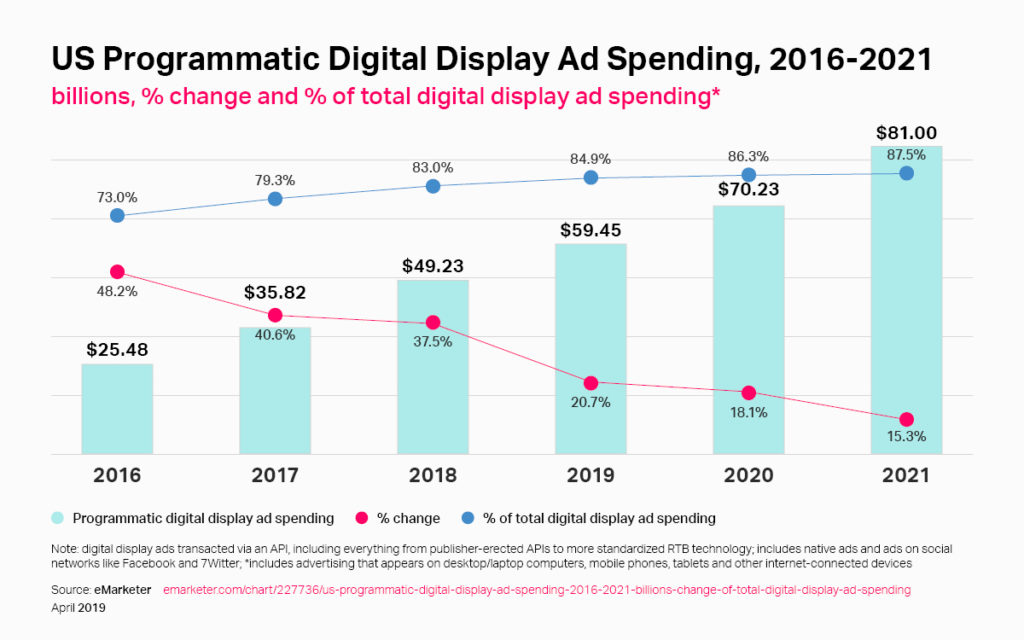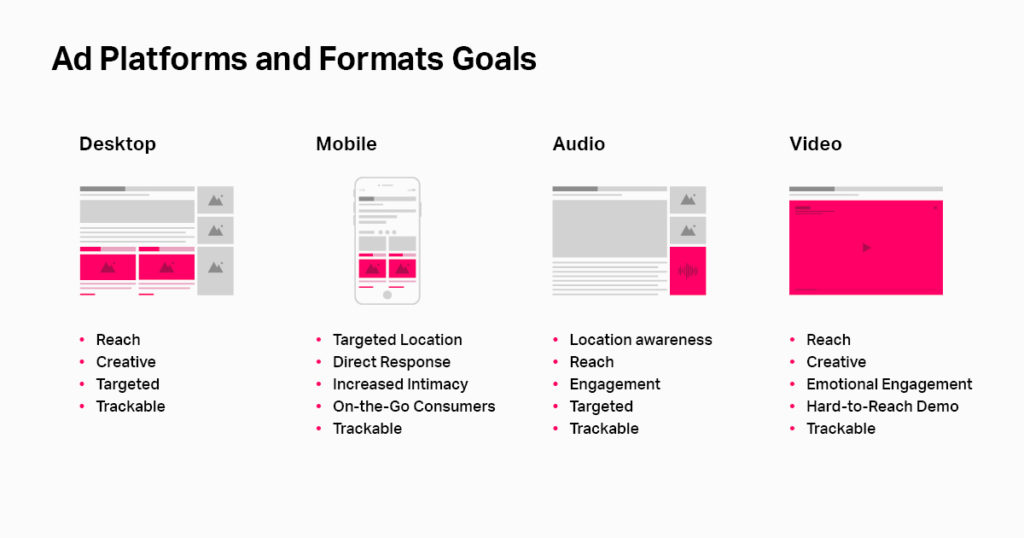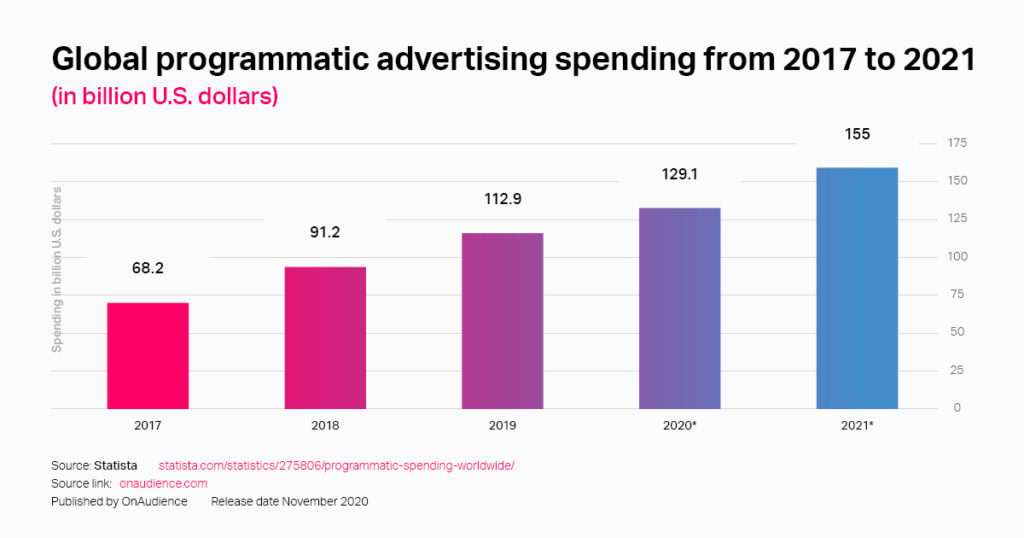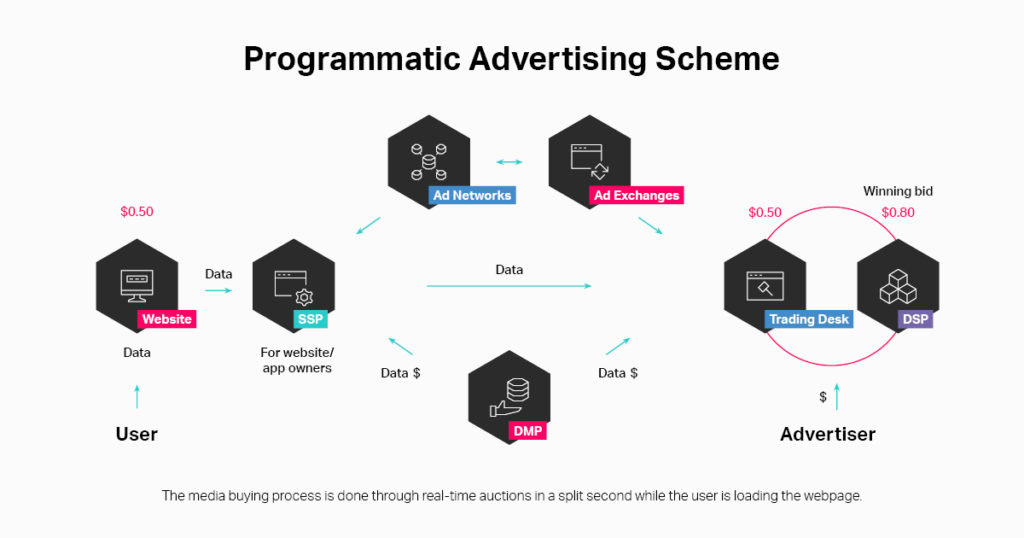Programmatic Advertising is an automated way of buying and managing all digital advertising without direct contact with a publisher. The media buying process is done through real-time auctions in a split second while loading the webpage.
The combination of two technologies like machine learning (ML) and artificial intelligence (AI) optimization and the string of cutting-edge marketing solutions led to programmatic advertising in the digital advertising market.
The extensive analysis of the US advertising market concluded that most of all transactions are done programmatically. By 2021, around 88% of all advertising profits in the US, which amounts to $81.00 billion, will occur through automated sales. By comparison, in 2015, only 62% of marketers were using programmatic in their ad campaigns, with predicted programmatic spending of $22.10 billion.

Find out more about programmatic advertising and why it is the advertising industry’s future in our complete guide on this topic and the best examples of implementing this technology.
The Rise of Programmatic Advertising
Programmatic in a nutshell, is the utilization of such technologies as AI and machine learning to purchase advertising in real-time, avoiding all human interactions with managers and negotiating prices.
However, we all know that there was a time when automated advertising buying was not possible.
The first digital ad appeared in 1994 in the Wired Magazine, and it promoted AT&T. Back in the days, online advertisement buying worked pretty much exactly as physical ads in real life. Sales managers would discuss with advertisers the place on a website and a period of advertising. The ad was always there, and no targeting was invented yet.
In 1995 the first central ad server was created to allow selling ads on numerous sites. However, many publishers and fewer advertisers have left many unsold ad spaces due to the uneven supply and demand. Advertising networks were created to solve this issue and sell unpurchased ad space from numerous publishers at a lower price. Then the highest bidder would buy these leftover spaces via auctions.
Sounds familiar, right? The problem that gave a push to the creation of programmatic advertising was targeting. Ad networks could not guarantee a view of the ad to the interested audience, so the Real-Time Bidding (RTB) came to the rescue.
RTB is a way to purchase and sell digital ads via auctions in real-time, so everything is processed while the page is being loaded. It helps show ads to people who match the advertiser’s criteria and are potentially interested in the service/product offered.
Suppose the regular way of placing ads would be manual, choosing the publisher with a similar theme (forum for young moms and baby food). In that case, RTB Protocol helps sell ads case by case, allowing for better targeting and showing advertising only to interested audiences.
Real-time bidding auctions set the foundation for the rise of the programmatic advertising which we use today. However, not all programmatic buying uses RTB, even though it is one of the main differences between more traditional models and programmatic one.
Another key difference is targeting. Traditional digital advertising techniques try to find the right audiences through the bigger range. At the same time, programmatic uses more precise targeting techniques based on knowledge about each particular user’s digital habits.
The more traditional waterfall model sells inventory to the prioritized advertisers or ad networks (previously evaluated by the publisher). The price is specified, and an ad spot is subsequently offered to each advertiser. The ad spot is sold to the first bidder who offers the floor price.
There are many differences between the models, with the main one being that programmatic is usually happening in real time, with all bidders having an equal chance to eventually win the ad space. On the other hand, with the waterfall model, a lot of manual evaluation is involved. The bidders have priority thus do not have equal chances of buying the inventory; the competition is not as high as programmatic because the bidding does not continue after the requested price is met, while programmatic publishers have more profits because the highest bid wins.
Different types of programmatic advertising
Before getting to know the types of programmatic deals available, there are two factors worth considering. First, they influence how the price and audience are formed and can further determine which type of deal is suitable for each case.
How is the price set?
Auction-based price is pretty self-explanatory and refers to the type of ad buying where the price for an inventory is determined by the highest bidder. Usually, it covers open auctions, first-price auctions, and second-price auctions.
Fixed price is a more traditional way of selling as space when the ad agency or a publisher predetermines the price. Preferred deal and programmatic direct/guaranteed are usually based on predetermined CPM.

Type of inventory
If the inventory is guaranteed or reserved, this usually is the characteristic of the programmatic guaranteed or automated guaranteed. This process resembles a traditional sale model when all conditions are negotiated ahead of the deal, and the actual purchase is automated. However, when the CPM is fixed but the inventory amount is not pre-set, we can observe an unreserved programmatic direct deal.
As we have mentioned, not all programmatic advertising goes through real-time bidding, but about 90% of it still works with RTB. It is simply yet another way to sell ads automatically, but not the only one. Programmatic Guaranteed (similar: Programmatic direct) and Private Marketplaces buying, for example, is not based on real-time auctions.
Programmatic Guaranteed is a purchase of a guaranteed amount of impression from a specific web source. It usually involves an agreement between the advertiser and the publisher as they negotiate the price directly. As a result, buyers can purchase top-quality inventory while the publishers can regulate the price. An agreement benefits both sides and helps prevent fraudulent ad practices due to the transparency of the interactions.
Private Marketplace (PMP) is a programmatic marketplace where publishers invite advertisers to bid on the specific ad space before it is available to anyone else. Only those invited can participate in the auction with some pre-set criteria involved. Thus, it is an auction for an exclusive group of advertisers.
Preferred Deal is similar to PMP, but it bypasses the auction process completely and sells the inventory with pre-set CPM to one particular buyer. As a result, publishers can have a stable flow of profits, and advertisers gain access to premium ad spaces with fixed prices.
Some more types of programmatic deals are more or less based on the RTB model
Open Auction – Ad Exchange (a digital marketplace where advertisers and publishers buy and sell ad spaces and inventory, using bidders in real time) connects buyers and sellers who participate in the transaction, and the highest bidder gets the ad space. It is the epitome of RTB.
First-Price Auction is a type of programmatic buying without a floor-price, where all advertisers offer their CPM’s at the same time and without knowing the other bids. Whoever proposes the first highest price – gets the inventory, setting the price per impression.
Second-Price Auction works similarly to the first-price one, but here the bids are visible. So the runner-up can determine the price in a second price auction, overbidding the known highest bid by a cent. The winner of the auction is technically still the one who offered more, with the difference that the advertiser can see the second-highest bid and set the price accordingly.
Header Bidding is a type of programmatic auction when publishers offer ad space to some marketplaces simultaneously making it available for certain demand partners before the bid reaches publisher ad servers. It is particularly lucrative for publishers as all participants engage directly, increasing the competition and offering great CPM’s.
Exchange Bidding (Open Bidding) is a server-side unified auction and Google’s answer to Header Bidding. During this process, ad exchanges and supply-side platforms compete alongside Google AdX and bid on ad spaces. The difference with Header Bidding is that the auction takes place server-side instead of the client-side and is integrated with Google allowing access to a limited number of partners.
The difference with Header Bidding is that the service is integrated with Google allowing access to a limited number of partners and functioning only on the server-side. As a result, header bidding is more versatile in this sense and has more partners available through Prebid and both server- and client-side options.
What are the benefits of programmatic advertising?
Considering the estimated programmatic spending in 2021 would be around $155 billion, it is only natural to assume that it benefits publishers and advertisers greatly. So let’s see what is special about it and how it holds up against traditional digital advertising techniques.

The advantages of programmatic buying for advertisers
- Access to wide audiences
Programmatic advertising is not limited to a certain ad inventory and allows to expand the reach significantly. - Flexible configurations
Advertisers can implement adjustments in the real-time mode according to the impressions and benefit from the wide range of settings available. - Targeting options
Programmatic is famous for its superb targeting, which can bring more revenue and utilize ads in the best possible way. Precise targeting can significantly affect the marketing campaign’s effectiveness; programmatic can help boost the efficiency factor. - Less manual actions and time
Everything is automated – this means less time and fewer interactions are needed. It can be beneficial in terms of money-saving and also human costs. - Transparent process
Programmatic makes ad buying into a fair and transparent interaction. It does not matter whether the advertiser is big or small. It still gives a lot of control over the whole purchasing process.
Benefits of programmatic advertising for publishers
- Easy to use and implement
Due to all processes being automated, the whole process of selling ads becomes much easier. Less time and effort are required to sell ad space and to optimize the monetization process. - Better reputation
Due to better targeting techniques, publishers can now serve more relevant ads, which increases the overall impression and reputability of the website. - Lower costs
Programmatic advertising can reduce spendings while raising yields from ad sales, helping to squeeze the maximum out of all, even less popular ad spaces. - Higher yield
Efficiency, clever targeting, bigger scope – all these factors attract advertisers, thus bringing more profits. - Easy collaboration with advertisers
The communication processes are simplified and direct, which makes partnership and dealings much faster and simpler. Moreover, it is possible to connect more partners simultaneously through Ad Exchanges.
What kind of platforms does programmatic advertising utilize?
There are a couple of solutions that implement programmatic advertising and can serve the needs of publishers and advertisers.

In the picture above, we can observe all of the participants of the programmatic marketplace ecosystem.
Demand-side platform (DSP) and Supply-side platform (SSP) are the most common tools to integrate programmatic advertising, but a few other participants are in this process.
Demand-side platform (DSP) – is a platform that helps advertisers manage all automatic media buying processes, including placing ads, bidding, moderation, and all other related communication. It is flexible in terms of settings and has multiple features such as fraud protection. As a result, it makes the whole process of optimizing ad buying much simpler. DSP also provides detailed reports that can be useful during the planning of advertising campaigns.
Trading Desk or ATD (Agency Trading Desk) is a centralized platform for media buying and managing that utilizes RTB logic and calibrates the programmatic buying variables. Usually, it works based on DSPs to get access to the available inventory. Advertisers can set different parameters such as maximum price per impression, targeting details, offers from SSP are compared with this info by DSP, considering the best possible match based on the trading desk data set by the advertiser.
Ad Exchange and Ad Networks are important parts of the programmatic ecosystem and share similar functions like gathering publishers’ inventory to automatically sell it to advertisers. However, they also differ in their purposes. Ad networks emerged at the rise of digital advertising to cope with scaling issues. Ad Networks serve as a layer between advertisers and publishers/ad agencies and aim to automate the deals, managing inventory and media buys. However, with the rise of programmatic buying and RTB, ad networks have become less viable. In this light, ad exchanges gained more popularity, as they trade ad inventory through open auctions in real time. Ad exchanges attract all participants of the programmatic ad marketplace eventually to sell ad space to the highest bidder. Many ad exchanges adopted the SSP name later on and dealt with issues such as scalability and access to the diverse audiences that ad networks could not solve.
Data management platform (DMP) is a software that collects, processes, and segments the audience intelligence for later targeting purposes. Such platforms help unify audiences across multiple websites, apps, etc., to organize ad campaigns through ad exchanges, ad networks, and demand-side platforms. It gathers data to “paint” a clearer customer profile based on such factors as demographics, occupation, interests, browsing behavior, purchasing history, geographical location, type of device used, and other criteria. All of this intel helps deliver the most relevant ads to the segment of the audience that would supposedly perform the best based on the info provided and analyzed by the DMPs.
Supply-side platform (SSP) – is similar to DSP but designed for publishers to manage all automated media sales. It eliminates the need for salespeople to manage and negotiate various interactions. The SSP links to an ad exchange and evaluates the available inventory; then, this inventory is auctioned to the highest bidder in real-time.
There is one more popular option that is based on the Supply-side platform logic. Header Bidding Platforms – is a unified solution for publishers that want to increase sales volumes with numerous customizable settings. Adtelligent Header Bidding Platform enables to hold all of the pre-bid auctions simultaneously via web-browser, server-side, or by implementing both approaches. It ensures an increase in sales income and highly detailed reporting for better optimization.
What do you need to know to start with programmatic advertising?
For Advertisers
As with everything in life, anyone who wants to start with a new venture must come prepared. The programmatic advertising market is still relatively young, and one must know its business’s goals and buyer’s persona to succeed. So for the newcomers in digital advertising, our advice would be the following:
- Get to know the technology
It is the first step to understanding how you can leverage it to the advantage of your specific needs. - Develop advertising strategy
Based on the existing digital data, you can determine short and long-term goals. This will help create a better path for the ad campaign in the future. - Choose a technology solution
Check marketing and advertising technology platforms you want to utilize. It should serve your goals and adjust to the specifics accordingly.
For Publishers
While programmatic advertising has clear benefits for advertisers and end users, it can also be a lucrative solution for publishers of any size. The best part is that while the programmatic optimizes the revenue from ad sales, it requires almost none of the work and is done automatically!
The main difficulty is to choose the right inventory for the desired goals. To do so, one must be acquainted with the platforms that make the implementation of programmatic ad sales possible.
Cases of programmatic integration
Programmatic is the technology of the future, and no wonder that it conquers the advertising industry as fast as it does. A lot of real-life examples of programmatic implementation can back it up and show its potential.
The Economist solved its issues with declining subscriptions by employing programmatic advertising, their data pools, and clever ad campaigns to attract curious readers who hadn’t previously spent much time on their website.
Sometimes programmatic advertising even saves lives. In the case of the Child Rescue Alert website, which implemented the technology to increase outreach. Thanks to the geographical targeting, they were able to show ads about missing people to the people in the area nearby. Better scope and targeting helped cover bigger and better audiences, thus assisting in finding people faster and raising awareness about the initiative.
Amanda Foundation is an organization that gives homeless pets a new home and promotes adoption. However, there is no similar pet, and all people are very different in their mentality and character. Therefore, the organization wanted to improve adoption rates by employing precise targeting and offering pets that would potentially fit the viewer’s lifestyle, age, and personality. The extremely personalized programmatic strategy was fruitful, and the foundation did get great results from a more personal programmatic approach.
StarLightMedia is the biggest media holding in Ukraine. It has a lot of shows and covers a wide range of audiences. Since implementing Adtelligent’s SSP and DSP five years ago, the company’s ad sales turnover has increased by 10 times. However, even with big coverage, programmatic can make the audiences more engaged and utilize this engagement more effectively.
Conclusions
As times change and the digital ecosystem evolves, it is important to know the most recent trends and technologies that can help advance your business. Whether you are an advertiser or a publisher, programmatic advertising can boost revenues and optimize work processes. It is easy to buy ads through automated auctions, having a chance to get the best audience for the most fruitful prices; for publishers, it brings more advertising partners and chances to sell inventory for better CMPs while saving up human and monetary resources. Technology has been on the rise for years and revolutionized the way people buy and sell ads online and assist in creating a more user-friendly online environment. Therefore, it is essential to tackle down one’s business objectives and choose the programmatic type suitable for the set goals, as programmatic advertising can improve all sorts of online ventures and perpetuate a more holistic digital ecosystem overall.